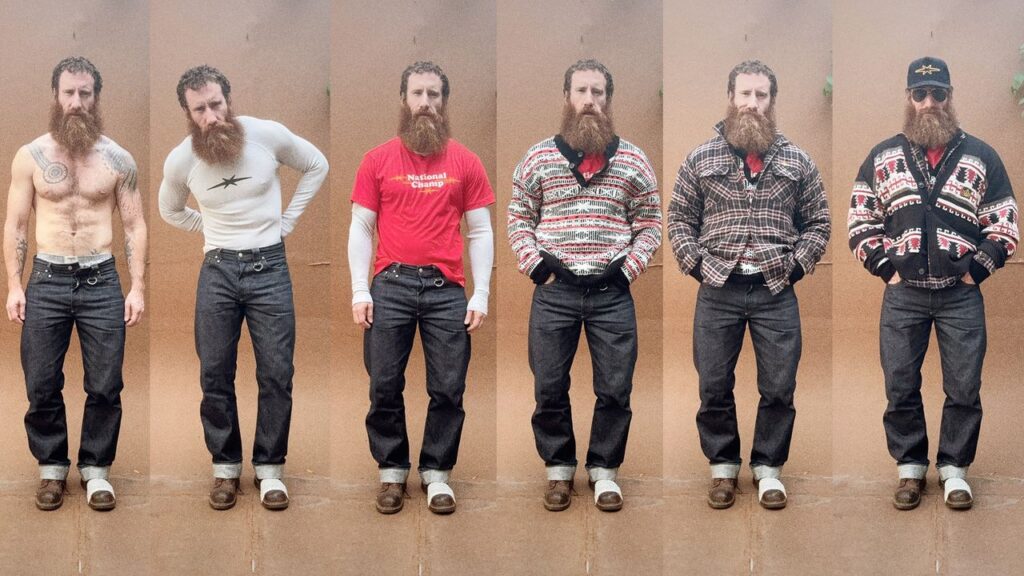If layering is an art form, Spencer Phipps is menswear’s Michelangelo. At his eponymous label, the LA-based designer subverts frontier Americana—studded flannel shirts, leather-paneled jeans—with a jocular, Tom of Finland-esque wink. The same approach animates his personal style, a glorious mishmash of shrunken rugby shirts, beat-to-hell work boots, slouchy carpenter pants, and bicep-hugging thermal tees, informed by his upbringing in the Bay Area and stints working for European heavyweights like Dries Van Noten.
Like any good designer, Phipps is his own best advertisement. (Being built like the statue of David’s brolic older brother helps.) On Instagram, where Phipps documents his outfits with a consistency that’d make a therapist proud, he models a can’t-be-taught carelessness that’s raised his label’s profile and landed him big-time styling gigs, including the chance to put Superman’s David Corenswet in multiple nubby, rough-hewn knits for a recent GQ Hype cover story. (Corenswet was a shade nonplussed at first, Phipps says, but he gamely played along.)
All of which makes him distinctly qualified to answer the question that plagues every menswear fan during the in-between season, when temperatures can fluctuate by 20 degrees in the span of a few hours: How the heck should I dress right now?
To get the low-down on leveling up your layering, GQ gave Phipps a call to discuss his no-fuss approach to getting dressed, how to know when you’re overdoing it, and why layering is the “quintessential definition of personal style.”
GQ: Spencer, as a true master of the form, do you abide by any fundamental rules of layering?
Spencer Phipps: There’s a few really key areas to consider. What’s on the outside, first of all, is the most important—what’s the top layer? And then you’ve got your cuffs, your neckline, and your waist, or, like, whatever’s going to stick out from the bottom of the top layer.
How do you decide which layers go where?
That’s just experimenting. In order to layer successfully, I think you have to essentially throw out everything you know about how to get dressed.
In what sense?
In the sense that putting things in the reverse order of how your parents would dress you might be the sickest move—not being afraid to make a bad mistake or to try something that seems on paper a little weird.
An easy way to make things feel cohesive is just sticking to a color palette. That’s kind of like beginner layering. There’s obviously more funky, clunky things you can do, like a little pop of color in the mix of five other things, but that’s advanced level.
I want to hear about the advanced level! There are, uh, layers to this.
There are different ways of thinking about it, too. I tend to grab the things that I like, and then put them on with less thought than you’d probably think.
I bet that’s partially the secret to it. You get dressed in a hurry and let the chips fall where they may.
Exactly. And you kind of don’t overthink it or worry about it too much. At the end of the day, the beauty of it all is that you can change if it’s really a mess.
You can shed layers.
Layering adds up really quick, too. It’s a way of taking a lot of lighter items and making something substantial. Like, if you layer enough T-shirts that’s a winter coat.
I know you’re on the West Coast, but East Coast winters are nowhere near as brutal as they used to be. If I layered strategically, I could probably get away with ditching the parka entirely.
Totally. A denim jacket could get you all the way through the winter if you’re smart about it.
If, in other words, you layer like an absolute madman.
What I like about the whole thing is that you can really customize your internal core temperature to exactly what you need it to be. If you have a T-shirt, and then you’ve got this big puffer jacket [over it], you’ve only got option A or option B.



